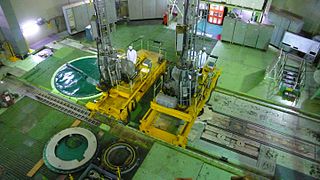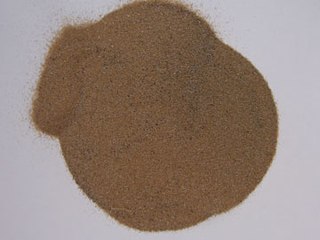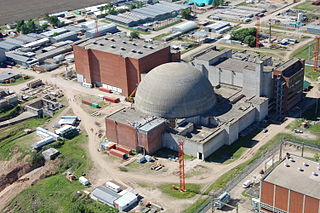
The CANDU is a Canadian pressurized heavy-water reactor design used to generate electric power. The acronym refers to its deuterium oxide moderator and its use of uranium fuel. CANDU reactors were first developed in the late 1950s and 1960s by a partnership between Atomic Energy of Canada Limited (AECL), the Hydro-Electric Power Commission of Ontario, Canadian General Electric, and other companies.

The Bhabha Atomic Research Centre (BARC) is India's premier nuclear research facility, headquartered in Trombay, Mumbai, Maharashtra, India. It was founded by Homi Jehangir Bhabha as the Atomic Energy Establishment, Trombay (AEET) in January 1954 as a multidisciplinary research program essential for India's nuclear program. It operates under the Department of Atomic Energy (DAE), which is directly overseen by the Prime Minister of India.
The Advanced CANDU reactor (ACR), or ACR-1000, was a proposed Generation III+ nuclear reactor design, developed by Atomic Energy of Canada Limited (AECL). It combined features of the existing CANDU pressurised heavy water reactors (PHWR) with features of light-water cooled pressurized water reactors (PWR). From CANDU, it took the heavy water moderator, which gave the design an improved neutron economy that allowed it to burn a variety of fuels. It replaced the heavy water cooling loop with one containing conventional light water, reducing costs. The name refers to its design power in the 1,000 MWe class, with the baseline around 1,200 MWe.

The water-water energetic reactor (WWER), or VVER is a series of pressurized water reactor designs originally developed in the Soviet Union, and now Russia, by OKB Gidropress. The idea of such a reactor was proposed at the Kurchatov Institute by Savely Moiseevich Feinberg. VVER were originally developed before the 1970s, and have been continually updated. As a result, the name VVER is associated with a wide variety of reactor designs spanning from generation I reactors to modern generation III+ reactor designs. Power output ranges from 70 to 1300 MWe, with designs of up to 1700 MWe in development. The first prototype VVER-210 was built at the Novovoronezh Nuclear Power Plant.
Kaiga Generating Station is a nuclear power generating station situated at Kaiga, near the river Kali, in Uttara Kannada district of Karnataka, India. The plant has been in operation since March 2000 and is operated by the Nuclear Power Corporation of India.

Madras Atomic Power Station (MAPS) located at Kalpakkam about 80 kilometres (50 mi) south of Chennai, India, is a comprehensive nuclear power production, fuel reprocessing, and waste treatment facility that includes plutonium fuel fabrication for fast breeder reactors (FBRs). It is also India's first fully indigenously constructed nuclear power station, with two units each generating 220 MW of electricity. The first and second units of the station went critical in 1983 and 1985, respectively. The station has reactors housed in a reactor building with double shell containment improving protection also in the case of a loss-of-coolant accident. An Interim Storage Facility (ISF) is also located in Kalpakkam.
The advanced heavy-water reactor (AHWR) or AHWR-300 is the latest Indian design for a next-generation nuclear reactor that burns thorium in its fuel core. It is slated to form the third stage in India's three-stage fuel-cycle plan. This phase of the fuel cycle plan was supposed to be built starting with a 300MWe prototype in 2016.
The Prototype Fast Breeder Reactor (PFBR) is a 500 MWe fast breeder nuclear reactor presently being constructed at Kalpakkam, India. The Indira Gandhi Centre for Atomic Research (IGCAR) is responsible for the design of this reactor. The facility builds on the decades of experience gained from operating the lower power Fast Breeder Test Reactor (FBTR). Originally planned to be commissioned in 2010, the construction of the reactor suffered from multiple delays. As of December 2022, the Prototype Fast Breeder Reactor was expected for completion in 2024(i.e. 20 years after the project was initially started). The numerous delays have made the project costlier over time and the project currently holds an infamous record of being the longest under-construction nuclear reactor project in the world.

Kakrapar Atomic Power Station is a nuclear power station in India, which lies in the proximity of Mandvi, Surat and Tapi river in the state of Gujarat.
The Rajasthan Atomic Power Station is a nuclear power plant located at Rawatbhata in the state of Rajasthan, India.
Nuclear power is the fifth-largest source of electricity in India after coal, gas, hydroelectricity and wind power. As of November 2020, India has 22 nuclear reactors in operation in 8 nuclear power plants, with a total installed capacity of 7,380 MW. Nuclear power produced a total of 43 TWh in 2020–21, contributing 3.11% of total power generation in India. 10 more reactors are under construction with a combined generation capacity of 8,000 MW.

India's three-stage nuclear power programme was formulated by Homi Bhabha, the well-known physicist, in the 1950s to secure the country's long term energy independence, through the use of uranium and thorium reserves found in the monazite sands of coastal regions of South India. The ultimate focus of the programme is on enabling the thorium reserves of India to be utilised in meeting the country's energy requirements. Thorium is particularly attractive for India, as India has only around 1–2% of the global uranium reserves, but one of the largest shares of global thorium reserves at about 25% of the world's known thorium reserves. However, thorium is more difficult to use than uranium as a fuel because it requires breeding, and global uranium prices remain low enough that breeding is not cost effective.
In Argentina, about 10% of the electricity comes from 3 operational nuclear reactors: Embalse, a CANDU reactor, and Atucha I and II, two PHWR German designs.
A pressurized heavy-water reactor (PHWR) is a nuclear reactor that uses heavy water (deuterium oxide D2O) as its coolant and neutron moderator. PHWRs frequently use natural uranium as fuel, but sometimes also use very low enriched uranium. The heavy water coolant is kept under pressure to avoid boiling, allowing it to reach higher temperature (mostly) without forming steam bubbles, exactly as for a pressurized water reactor. While heavy water is very expensive to isolate from ordinary water (often referred to as light water in contrast to heavy water), its low absorption of neutrons greatly increases the neutron economy of the reactor, avoiding the need for enriched fuel. The high cost of the heavy water is offset by the lowered cost of using natural uranium and/or alternative fuel cycles. As of the beginning of 2001, 31 PHWRs were in operation, having a total capacity of 16.5 GW(e), representing roughly 7.76% by number and 4.7% by generating capacity of all current operating reactors.

The Atucha Nuclear Complex, or Atucha Nuclear Power Plant, is the location for two adjacent nuclear power plants in Lima, Zárate, Buenos Aires Province, about 100 kilometres (60 mi) from Buenos Aires, on the right-hand shore of the Paraná de las Palmas River. Both are pressurized heavy-water reactors (PHWR) employing a mixture of natural uranium and enriched uranium, and use heavy water for cooling and neutron moderation.

The Gorakhpur Nuclear Power Plant or the Gorakhpur Haryana Anu Vidyut Pariyojana (GHAVP) is a proposed nuclear power plant to be built on a 560 hectares area west of Gorakhpur village of Fatehabad district of Haryana.

Sekhar Basu was an Indian nuclear scientist who served as the chairman of the Atomic Energy Commission and Secretary to the Government of India, Department of Atomic Energy (DAE). He also served as the Director of Bhabha Atomic Research Centre (BARC), the Project Director of Nuclear Submarine Program, and later as the Chief Executive of the Nuclear Recycle Board at Bhabha Atomic Research Center. He was a recipient of India's fourth highest civilian honor Padma Shri in 2014.

The IPHWR-700 is an Indian pressurized heavy-water reactor designed by the NPCIL. It is a Generation III reactor developed from earlier CANDU based 220 MW and 540 MW designs. It can generate 700 MW of electricity. Currently there are 5 units under construction and 10 more units planned, at a cost of ₹1.05 lakh crore (US$13 billion).

The IPHWR-220 is an Indian pressurized heavy-water reactor designed by the Bhabha Atomic Research Centre. It is a Generation II reactor developed from earlier CANDU based RAPS-1 and RAPS-2 reactors built at Rawatbhata, Rajasthan. It can generate 220 MW of electricity. Currently, there are 14 units operational at various locations in India. It is sometimes referred to as an small modular reactor due to its modularization.
The Indian Pressurized Water Reactor-900 (IPWR-900) is a class of pressurized water reactors being designed by Bhabha Atomic Research Centre (BARC) in partnership with Nuclear Power Corporation of India Limited to supplement the Indian three-stage nuclear power programme










